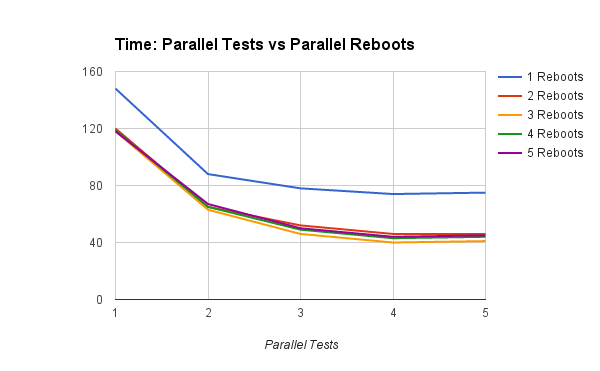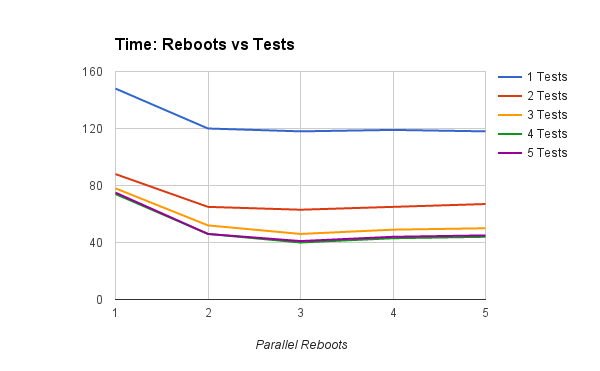Test Suite - Performance: Difference between revisions
(only performance) |
(Show how to get boot time) |
||
| Line 1: | Line 1: | ||
== Boot Time == | |||
What a VM is doing while it is booting can be determined using <tt>systemd-analyze blame</tt>. Remember to boot the VM twice (the very first boot will be slightly longer while the guest is properly configured): | |||
<pre> | |||
$ ./testing/utils/kvmsh.py --boot cold w.east systemd-analyze blame | |||
virsh 0.01: starting domain | |||
virsh 15.05: 'login: ' matched after 13.7 seconds | |||
virsh 15.05: waiting 10 seconds for login prompt; 5 seconds for password prompt; 5 seconds for shell prompt | |||
virsh 15.05: 'login: ' matched after 0.0 seconds | |||
virsh 15.09: We're in after 0.5 seconds! | |||
[root@east ~]# systemd-analyze blame | |||
7.576s network.service | |||
843ms dev-vda1.device | |||
781ms initrd-switch-root.service | |||
776ms systemd-vconsole-setup.service | |||
679ms sssd.service | |||
526ms systemd-udev-trigger.service | |||
235ms sysroot.mount | |||
180ms dev-mqueue.mount | |||
174ms dracut-cmdline.service | |||
170ms kmod-static-nodes.service | |||
162ms systemd-journald.service | |||
159ms sys-kernel-debug.mount | |||
152ms dev-hugepages.mount | |||
151ms user@0.service | |||
144ms systemd-tmpfiles-setup-dev.service | |||
144ms systemd-tmpfiles-setup.service | |||
143ms systemd-remount-fs.service | |||
137ms testing.mount | |||
135ms fedora-readonly.service | |||
135ms systemd-modules-load.service | |||
127ms source.mount | |||
119ms systemd-journal-flush.service | |||
107ms initrd-parse-etc.service | |||
.... | |||
</pre> | |||
== Speeding up "make kvm-test" by running things in parallel == | == Speeding up "make kvm-test" by running things in parallel == | ||
Revision as of 03:41, 25 October 2018
Boot Time
What a VM is doing while it is booting can be determined using systemd-analyze blame. Remember to boot the VM twice (the very first boot will be slightly longer while the guest is properly configured):
$ ./testing/utils/kvmsh.py --boot cold w.east systemd-analyze blame
virsh 0.01: starting domain
virsh 15.05: 'login: ' matched after 13.7 seconds
virsh 15.05: waiting 10 seconds for login prompt; 5 seconds for password prompt; 5 seconds for shell prompt
virsh 15.05: 'login: ' matched after 0.0 seconds
virsh 15.09: We're in after 0.5 seconds!
[root@east ~]# systemd-analyze blame
7.576s network.service
843ms dev-vda1.device
781ms initrd-switch-root.service
776ms systemd-vconsole-setup.service
679ms sssd.service
526ms systemd-udev-trigger.service
235ms sysroot.mount
180ms dev-mqueue.mount
174ms dracut-cmdline.service
170ms kmod-static-nodes.service
162ms systemd-journald.service
159ms sys-kernel-debug.mount
152ms dev-hugepages.mount
151ms user@0.service
144ms systemd-tmpfiles-setup-dev.service
144ms systemd-tmpfiles-setup.service
143ms systemd-remount-fs.service
137ms testing.mount
135ms fedora-readonly.service
135ms systemd-modules-load.service
127ms source.mount
119ms systemd-journal-flush.service
107ms initrd-parse-etc.service
....
Speeding up "make kvm-test" by running things in parallel
Internally kvmrunner.py has two work queues:
- a pool of reboot threads; each thread reboots one domain at a time
- a pool of test threads; each thread runs one test at a time using domains with a unique prefix
The test threads uses the reboot thread pool as follows:
- get the next test
- submit required domains to reboot pool
- wait for domains to reboot
- run test
- repeat
My adjusting KVM_WORKERS and KVM_PREFIXES it is possible:
- speed up test runs
- run independent testsuites in parallel
The reboot thread pool - make KVM_WORKERS=...
Booting the domains is the most CPU intensive part of running a test, and trying to perform too many reboots in parallel will bog down the machine to the point where tests time out and interactive performance becomes hopeless. For this reason a pre-sized pool of reboot threads is used to reboot domains:
- the default is 1 reboot thread limiting things to one domain reboot at a time
- KVM_WORKERS specifies the number of reboot threads, and hence, the reboot parallelism
- increasing this allows more domains to be rebooted in parallel
- however, increasing this consumes more CPU resources
To increase the size of the reboot thread pool set KVM_WORKERS. For instance:
$ grep KVM_WORKERS Makefile.inc.local KVM_WORKERS=2 $ make kvm-install kvm-test [...] runner 0.019: using a pool of 2 worker threads to reboot domains [...] runner basic-pluto-01 0.647/0.601: 0 shutdown/reboot jobs ahead of us in the queue runner basic-pluto-01 0.647/0.601: submitting shutdown jobs for unused domains: road nic north runner basic-pluto-01 0.653/0.607: submitting boot-and-login jobs for test domains: east west runner basic-pluto-01 0.654/0.608: submitted 5 jobs; currently 3 jobs pending [...] runner basic-pluto-01 28.585/28.539: domains started after 28 seconds
Only if your machine has lots of cores should you consider adjusting this in Makefile.inc.local.
The tests thread pool - make KVM_PREFIXES=...
Note that this is still somewhat experimental and has limitations:
- stopping parallel tests requires multiple control-c's
- since the duplicate domains have the same IP address, things like "ssh east" don't apply; use "make kvmsh-<prefix><domain>" or "sudo virsh console <prefix><domain" or "./testing/utils/kvmsh.py <prefix><domain>".
Tests spend a lot of their time waiting for timeouts or slow tasks to complete. So that tests can be run in parallel the KVM_PREFIX provides a list of prefixes to add to the host names forming unique domain groups that can each be used to run tests:
- the default is no prefix limiting things to a single global domain pool
- KVM_PREFIXES specifies the domain prefixes to use, and hence, the test parallelism
- increasing this allows more tests to be run in parallel
- however, increasing this consumes more memory and context switch resources
For instance, setting KVM_PREFIXES in Makefile.inc.local to specify a unique set of domains for this directory:
$ grep KVM_PREFIX Makefile.inc.local KVM_PREFIX=a. $ make kvm-install [...] $ make kvm-test [...] runner 0.018: using the serial test processor and domain prefix 'a.' [...] a.runner basic-pluto-01 0.574: submitting boot-and-login jobs for test domains: a.west a.east
And setting KVM_PREFIXES in Makefile.inc.local to specify two prefixes and, consequently, run two tests in parallel:
$ grep KVM_PREFIX Makefile.inc.local KVM_PREFIX=a. b. $ make kvm-install [...] $ make kvm-test [...] runner 0.019: using the parallel test processor and domain prefixes ['a.', 'b.'] [...] b.runner basic-pluto-02 0.632/0.596: submitting boot-and-login jobs for test domains: b.west b.east [...] a.runner basic-pluto-01 0.769/0.731: submitting boot-and-login jobs for test domains: a.west a.east
creates and uses two dedicated domain/network groups (a.east ..., and b.east ...).
Finally, to get rid of all the domains use:
$ make kvm-uninstall
or even:
$ make KVM_PREFIX=b. kvm-uninstall
Two domain groups (e.x., KVM_PREFIX=a. b.) seems to give the best results.
Recommendations
Some Analysis
The test system:
- 4-core 64-bit intel
- plenty of ram
- the file mk/perf.sh
Increasing the number of parallel tests, for a given number of reboot threads:
- having #cores/2 reboot threads has the greatest impact
- having more than #cores reboot threads seems to slow things down
Increasing the number of reboots, for a given number of test threads:
- adding a second test thread has a far greater impact than adding a second reboot thread - contrast top lines
- adding a third and even fourth test thread - i.e., up to #cores - still improves things
Finally here's some ASCII art showing what happens to the failure rate when the KVM_PREFIX is set so big that the reboot thread pool is kept 100% busy:
Fails Reboots Time
************ 127 1 6:35 ****************************************
************** 135 2 3:33 *********************
*************** 151 3 3:12 *******************
*************** 154 4 3:01 ******************
Notice how having more than #cores/2 KVM_WORKERS (here 2) has little benefit and failures edge upwards.
Desktop Development Directory
- reduce build/install time - use only one prefix
- reduce single-test time - boot domains in parallel
- use the non-prefix domains east et.al. so it is easy to access the test domains using tools like ssh
Lets assume 4 cores:
KVM_WORKERS=2 KVM_PREFIX=''
You could also add a second prefix vis:
KVM_PREFIX= '' a.
but that, unfortunately, slows down the the build/install time.
Desktop Baseline Directory
- do not overload the desktop - reduce CPU load by booting sequentially
- reduce total testsuite time - run tests in parallel
- keep separate to development directory above
Lets assume 4 cores
- KVM_WORKERS=1
- KVM_PREFIX= b1. b2.
Dedicated Test Server
- minimize total testsuite time
- maximize CPU use
- assume only testsuite running
Assuming 4 cores:
* KVM_WORKERS=2 * KVM_PREFIX= '' t1. t2. t3.

